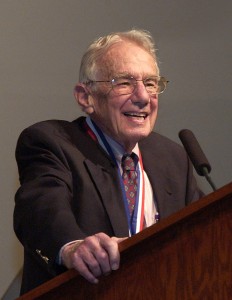Mar 9 2010
Pioneering French physicists Marie and Pierre Curie have the curie, a unit of radioactivity, named after them. Renowned inventor Nikola Tesla is honored with the tesla, which measures a magnetic field. And now, the Rosenfeld, proposed as a unit for electricity savings, will be named after the man seen by many people as the godfather of energy efficiency, Arthur Rosenfeld.
 (Courtesy California Energy Commission)
(Courtesy California Energy Commission)
“In keeping with the tradition among scientists of naming units in honor of the person most responsible for the discovery and widespread adoption of the underlying scientific principle in question,” a group of scientists propose today in a refereed article in Environmental Research Letters to define the Rosenfeld as electricity savings of 3 billion kilowatt-hours per year, the amount needed to replace the annual generation of a 500 megawatt coal-fired power plant.
That definition, explains lead author Jonathan Koomey, a Lawrence Berkeley National Laboratory (Berkeley Lab) scientist and consulting professor at Stanford University who was once a graduate student of Rosenfeld’s, is classic Rosenfeld. “Power plants are what Art uses most often to explain to policy makers how much electricity can be saved by efficiency investments,” Koomey said.
With a decades-long career in energy analysis and standards, Rosenfeld is often credited with being personally responsible for billions of dollars in energy savings. He started his career at UC Berkeley and Berkeley Lab in the 1950s as a physicist in the Nobel Prize-winning particle physics group of Luis Alvarez. However, in 1974, he decided to switch his focus to energy and the environment. He founded the Center for Building Science at Berkeley Lab in 1975, where a broad range of energy efficiency standards and technologies were developed over the next 20 years.
Having just completed two five-year terms on the California Energy Commission, Rosenfeld will be returning to Berkeley Lab this spring to continue championing scientific solutions for society’s most urgent environmental problems.
“He recognized early on, earlier than anyone else I think, that really great gains will come from energy efficiency, that there’s an enormity to be gained by this approach,” said fellow physicist Richard Muller, who took a graduate course from Rosenfeld in 1965, then went on to work with him in Alvarez’ group.
Indeed, he already has a term named after him: the “Rosenfeld effect” explains why California’s per capital electricity usage has remained flat since the mid-1970s while U.S. usage has climbed steadily and is now 50 percent higher than it was 40 years ago. Low-emissivity “smart windows,” electronic ballasts that led to compact fluorescent lamps and energy standards for appliances and buildings were Berkeley Lab innovations that made the Rosenfeld effect possible. The term has been popularized by U.S. Secretary of Energy Stephen Chu, who has called Rosenfeld a hero of his.
He is also behind “Rosenfeld’s Law,” which states that the amount of energy required to produce one dollar of economic output has decreased by about 1 percent per year since 1845.
Published online today, the paper proposing the Rosenfeld unit of measurement, entitled “Defining a standard metric for electricity savings,” has 54 co-authors representing 26 institutions from around the world, including more than a dozen from Berkeley Lab.
Ashok Gadgil, acting director of Berkeley Lab’s Energy and Environmental Technologies Division and one of the co-authors, said it’s the right unit at the right time. “We’re launching this definition at a time when we’re on the cusp, I think, from not worrying about carbon emissions to worrying like crazy about carbon emissions. It’s also a very practical way to think about energy resources.”
Rosenfeld himself is not sure whether to take the whole thing too seriously. “I’m honored that Jon Koomey got 53 of my oldest friends to join together on such a nice thought,” he said. He added that he has always tried to explain energy savings in terms that people can grasp, such as the energy use of a home, a car or a power plant. “This nice article is really the result of the early usefulness of using cars, homes and power plants as an example of savings from energy efficiency,” he said.
Not everyone is supporting the new unit. Muller, for one, says there are already too many units for measuring energy, such as joules, quads or BTUs, and he would rather see Rosenfeld given an even higher honor. “I believe Art Rosenfeld deserves the Nobel Peace Prize more than many people who’ve received it,” Muller said. “Energy conservation has prevented conflict around the world.”
Regardless of whether Rosenfeld the unit catches on, Rosenfeld the man has not slowed down. “He’ll continue to work on things that catch his imagination, which is the whole world,” said Gadgil. “You can’t box this guy in.”